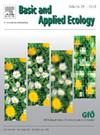亚山地草甸管理对千足虫群落结构的影响
IF 3.5
2区 环境科学与生态学
Q2 ECOLOGY
引用次数: 0
摘要
半自然的山地草甸是生物多样性丰富的栖息地,需要适当的管理和保护;然而,管理对千足虫群落的影响仍未得到充分研究。2018年,我们使用陷阱调查了斯洛伐克中部10个地区30块刈割、放牧和废弃草地上的千足虫群落。共采集到15种705株。刈割草地的平均活动密度最高(43.4个),物种丰富度最高(5.6个),Shannon多样性最高(H = 1.32);弃置草甸的平均值最低(9.6个,2.9种,H = 0.83)。不同生境类型的物种组成存在差异,项目巨穗草(Megaphyllum projectum)倾向于放牧草地,transsilvanicus和Mastigona bosniensis倾向于管理草地(修剪和放牧),而tetrasticha在废弃草地中更为丰富。样地面积和到连续林的距离是群落组成的重要预测因子。千足虫活动密度随样地面积的增加而增加,随距连片林距离的增加而降低。物种丰富度也与样地面积呈正相关,但随土壤含氮量的增加而降低。土壤氮对Shannon多样性有负向影响,而太阳辐射对Shannon多样性有正向影响。割草成为最合适的管理方法,而放牧和放弃则不太有利。本文章由计算机程序翻译,如有差异,请以英文原文为准。
The impact of submontane meadows management on the structure of millipede (Diplopoda) communities
Semi-natural submontane meadows are biodiversity-rich habitats that require appropriate management for conservation; however the effects of management on millipede communities remain understudied. We investigated millipede communities across 30 plots in mowed, grazed, and abandoned meadows at 10 localities in central Slovakia using pitfall traps in 2018. In total, 705 individuals from 15 species were collected. Mowed meadows had the highest average activity density (43.4 individuals), species richness (5.6 species), and Shannon diversity (H = 1.32), followed by grazed meadows. In contrast, abandoned meadows showed the lowest average values (9.6 individuals, 2.9 species, H = 0.83). Species composition differed across habitat types, with Megaphyllum projectum favouring grazed meadows and Unciger transsilvanicus and Mastigona bosniensis preferring managed meadows (mowed and grazed), and Glomeris tetrasticha was more abundant in abandoned meadows. Plot area and distance to continuous forest were identified as significant predictors of community composition. Millipede activity density increased with plot area but declined with increasing distance from continuous forest. Species richness also showed a positive relationship with plot area but decreased with higher soil nitrogen content. Soil nitrogen further had a negative effect on Shannon diversity, whereas solar radiation exerted a positive influence. Mowing emerged as the most suitable management practice, whereas grazing and abandonment were less favourable.
求助全文
通过发布文献求助,成功后即可免费获取论文全文。
去求助
来源期刊

Basic and Applied Ecology
环境科学-生态学
CiteScore
6.90
自引率
5.30%
发文量
103
审稿时长
10.6 weeks
期刊介绍:
Basic and Applied Ecology provides a forum in which significant advances and ideas can be rapidly communicated to a wide audience. Basic and Applied Ecology publishes original contributions, perspectives and reviews from all areas of basic and applied ecology. Ecologists from all countries are invited to publish ecological research of international interest in its pages. There is no bias with regard to taxon or geographical area.
 求助内容:
求助内容: 应助结果提醒方式:
应助结果提醒方式:


